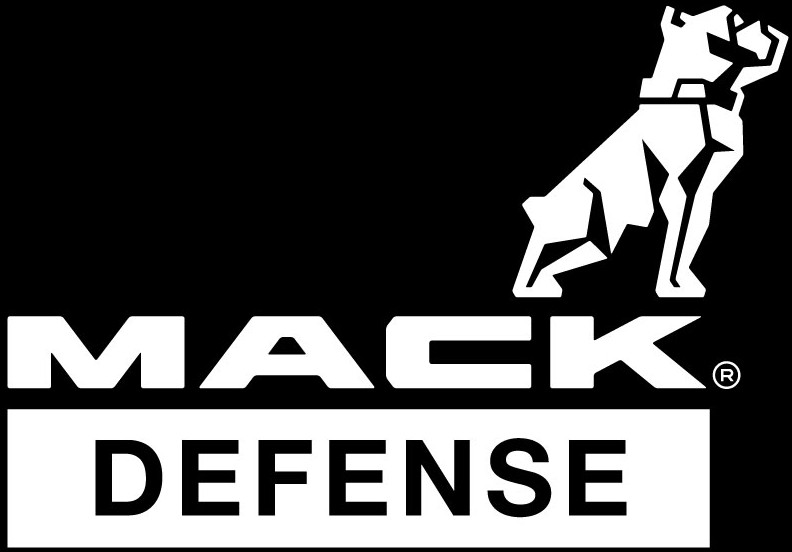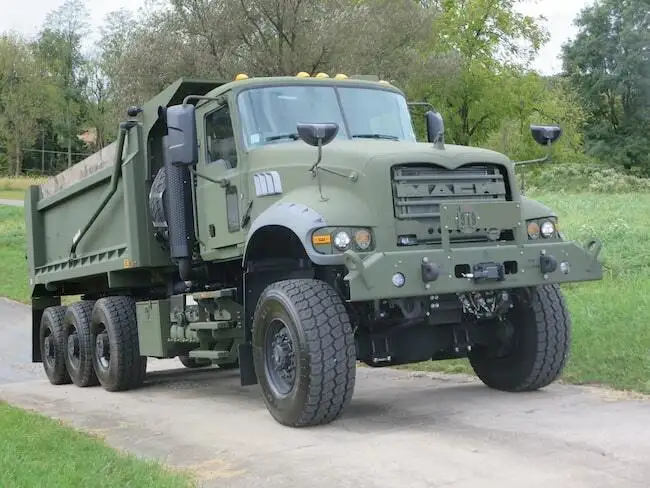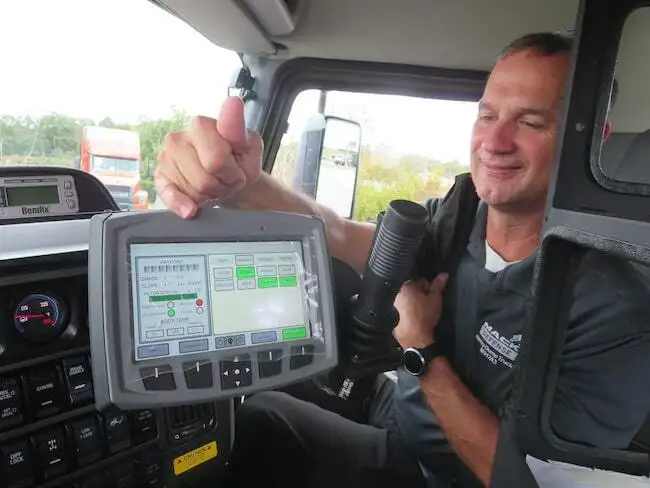The view from the driveway in front of Mack’s Customer Experience Center in Allentown, Pennsylvania, was impressive. Several military dump trucks were parked on concrete pads near the building, looking almost menacing with their high stance and dull green and desert tan paint.
They were copies of the Army’s latest heavy dump truck that Mack Defense is assembling on a special line here. Designated M917A3, the Granite-based Mack heavy trucks are 8x8s with a high tractive effort and hefty carrying capacity, on and off-road. They are rugged but easy to pilot, and ride nicely over smooth pavement but bounce a bit when the going gets tough.
After careful bidding and extensive testing, the U.S. Army has committed to buying hundreds of Mack M917A3 heavy on/off-road dump trucks, which are based on its Granite model.
That was my experience on this early autumn day, first on a 3/4-mile asphalt-paved track that encircles these facilities, then on a cross-country course that included short but steep grades, simulated cobblestones, dirt paths, and a stone roadway. My guide was Jack Terefinko, Mack Defense’s project manager for this model. He explained that the company won a contract worth as much as $296.4 million over seven years to produce up to 683 standard and armored M917A3s. So far the service has ordered 151 trucks that will be split among the active Army, Army Reserve, and National Guard. As they have with predecessor M917s from AM General and Freightliner, those branches will use the Macks for various construction and paving projects wherever the action is, and the Guard can also use them to help communities in rescue and cleanup work following natural and human-caused disasters.
A driver and an assistant climb aboard via three slip-resistant steps plus another step into the cab. The cab sits about 4 inches higher than that on a stock Granite, primarily because of the military truck’s front driving axle and its attendant transfer case and a drive shaft that runs under the cab and engine. Inside, the interior was pretty much standard Granite, including instrument panels and flat-bottom steering wheel. The Army spec’d several electronic safety features, including forward collision mitigation and side blind-spot detection. Other additions included a small color touch screen with body controls that protruded from the dash, and standing between the driver and passenger was a bulky radio rack. “I don’t like this,” I griped as my arm rubbed against the rack. “You get used to it,” Terefinko replied, and I did.
The engine, a 782-cubic-inch 440-horsepower Mack MP8, cranked over easily and fired up with a throaty roar out of its single black exhaust stack. The diesel has no aftertreatment equipment because it’s exempt from emissions limits. The Army operates in many places where ultra-low-sulfur diesel fuel is not available, and the engine burns relatively high-sulfur JP8 aviation fuel. It is electronically controlled, however, and not much smoke leaves the stack. Officials said an M917A3 is about 80 percent stock Granite and 20 percent military, including bulky steel lifting eyes and tow hooks, and air gladhands fore and aft so the truck can tow and be towed.
Mack M917A3 Specs
- Truck: Mack Granite M917A3, set-forward axle daycab, 300x90x11.1 mm with double-channel steel mainframe, GVW 94,400 lb.
- Engine: 12.8L pre-emission Mack MP8, 440 hp/1,660 lb.-ft., w/ engine brake
- Transmission: Allison 4500 6-speed torque converter automatic, Gen5 w/ prognostics
- Steer axle: 25,000-lb. Meritor MX-810 on Hendrickson parabolic leafs
- Rear tridem axles: 76,800-lb. Meritor 34836 P600/ProTec Series 50 on Hendrickson PriMaax Pax 792 high stability air-ride
- Wheelbase: 245 in.
- Brakes: Meritor EX+ air disc brakes front, Meritor S-Cam 16.5×7-in. Q+ drums rear
- Tires & wheels: Michelin 245/65R22.5 wide-base singles on steel discs
- Body: Crysteel 18-ft., 18-cubic-yard Hardox steel
Above: Jack Terefinko, Mack Defense’s project manager for this truck series, shows the touch screen that controls the dump body. He’s peering around a rack that will hold radios and other communications gear.
Moving out is like being in a civilian Granite: Release the parking brake, step on the brake pedal, and push D for drive on the dash-mounted selector, then step on the accelerator and let the Allison automatic transmission do the shifting work. Although the powered front axle was freewheeling, it seemed to drag a bit on the steering gear and the three rear drive axles tended to push the truck straight forward, so the power steering was not effortless.
Terefinko directed me onto the oval track where I accelerated to 35 and 40 mph, and we cruised for a couple of laps. Then I exited toward a road that went up a 15-percent grade, over a hump, then down more gently to rejoin the oval. I backed down the grade and restarted several times, noting how easily the MP8’s torque and the Allison’s torque converter overcame inertia as the truck moved upward on the hill. In the olden days, meaning my Army time in the mid-1960s, trucks like this had manual transmissions, and it took some training and practice to operate them. As time went on, the military increasingly found that young GIs had never driven any kind of “stick shift” transmission, so automatics, which had advanced in durability and capability, made more sense and still do.
Moving onto the cross-country course put the truck and me through some serious bouncing. The tridem sat on air bags and the cab and seat were also air suspended, but banging over rough surfaces sent lots of shock our way. A look at the specifications helps explain why: The Meritor tridem and its Hendrickson PriMaxx suspension (modified for several extra inches of vertical travel) were rated for 76,800 pounds and the steer axle and its parabolic flat-leaf suspension, from the same suppliers, can carry up to 25,000 pounds. With no load in the Crysteel dump box, I couldn’t expect a limo ride. With a full payload of 27 tons on-road (and about 14 off), the truck would have settled down.
The brief workout we gave the big Mack on this day was nothing compared to what the Army put a dozen brothers through at its Aberdeen Proving Ground in Maryland. Testing included running trucks over severe terrain and through water and thick mud in all kinds of weather, Mack Defense people said. Four trucks with blast-resistant armored cabs and shielded fuel and hydraulic tanks were blown up, as they could be in a roadside bomb, to be sure those components stayed intact; they did. Nonhardened parts did not, and after one blast, a “snipe hunt” ensued to find the bulldog hood ornament, an Army officer quipped. Either standard or armored cab can substitute for another in about 16 man-hours of removal and installation work. An armored cab weighs 8,000 pounds, four times more than the stock cab, so an armored truck’s payload is reduced accordingly, Terefinko said.
Army officials say they are pleased with the trucks and the builder’s performance during the bidding, production, and testing stages, and they are talking with Mack Defense executives about follow-on orders for variants on the M917A3. These would include an 8×8 with a 40-ton crane and a 6×4 linehaul tractor. The company has built prototypes of those but must compete with other manufacturers to win any orders. Meanwhile, because military trucks can see tough duty but usually run low mileage, these dumpers will probably work for much of this century before retirement.
For more information about the Mack Heavy Dump Truck, visit mackdefense.org. Link To The Article On Construction Equipment Located HERE
Mack Defense, a wholly-owned subsidiary of Mack Trucks, is responsible for the sale of heavy-duty trucks to federal- and ministerial-level customers globally. For more information, please visit mackdefense.org.
Mack Defense, LLC, is part of the Volvo Group, one of the world’s leading manufacturers of trucks, buses, construction equipment, and marine and industrial engines. The Group also provides complete solutions for financing and service. The Volvo Group, which employs almost 100,000 people, has production facilities in 18 countries and sells its products in more than 190 markets. In 2018, the Volvo Group’s sales amounted to about $43 billion. The Volvo Group is a publicly held company headquartered in Gothenburg, Sweden. Volvo shares are listed on Nasdaq Stockholm. For more information, please visit www.volvogroup.com.



